2019.03.29Field Report
Being a Part of the "AKARI" Bringing Light to People Project, Report by Volunteer Employee Reporters
2014.01.29 Field Report
Panasonic donated 4,500 solar lanterns (new model BG-BL03) in Myanmar and Cambodia in November and December 2013. This report covers the new model launch event and donation ceremony for the recipient organizations.
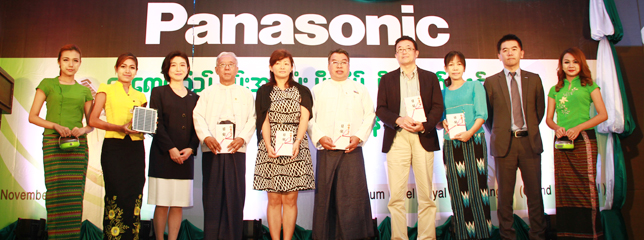
Hello, this is Akira Hoshi of the CSR & Citizenship Group.
From November 27 through December 7, I went to Myanmar and Cambodia on behalf of the company to donate a total of 4,500 solar lanterns. The lanterns are a new product (BG-BL03) launched in October 2013.
On November 29, 2013 in Yangon, the former capital of Myanmar, we held a press conference of the new product scheduled for sales launch in January 2014 along with a donation ceremony. More than one hundred people, including guests, members of the five recipient organizations, and the media, gathered at the Chatrium Hotel Royal Lake Yangon. The event kicked off with a greeting by the Chief Representative of Panasonic Asia Pacific Pte. Ltd. Myanmar Branch followed by the new product announcement and donation ceremony. The final press question and answer session was a dynamic session which revealed the people's genuine interest in the new product and the 100 Thousand Solar Lanterns Project.
The year 2013 marked the fortieth year of Japan's relations with the Association of South-East Asian Nations (ASEAN), and the solar lantern initiative was endorsed by Japan's Ministry of Foreign Affairs as a project for Celebrating the 40 Year of ASEAN-Japan Friendship and Cooperation.
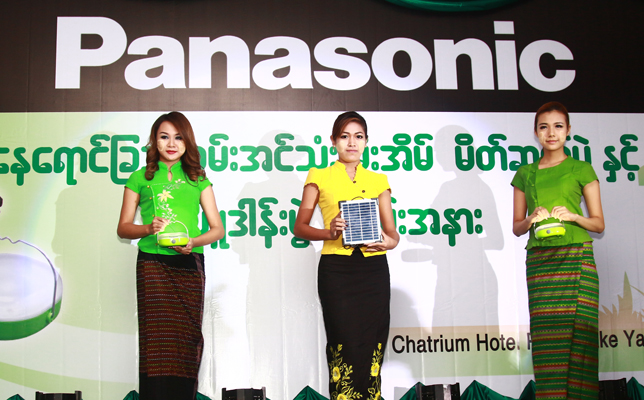
New product announcement
A local non-governmental organization named Saetanar was a new recipient in Myanmar. Saetanar, meaning "thoughtfulness" and "good will" in the national language, is an organization working in the Shan State, region that borders China, Thailand and Laos. Based on the philosophy that "sustained basic education is indispensable for the progress of a community," this group promotes rural development through school construction. It has built approximately 200 schools in the past ten years, to give children the opportunity to learn. The solar lanterns will be used in these schools, mostly in classrooms.
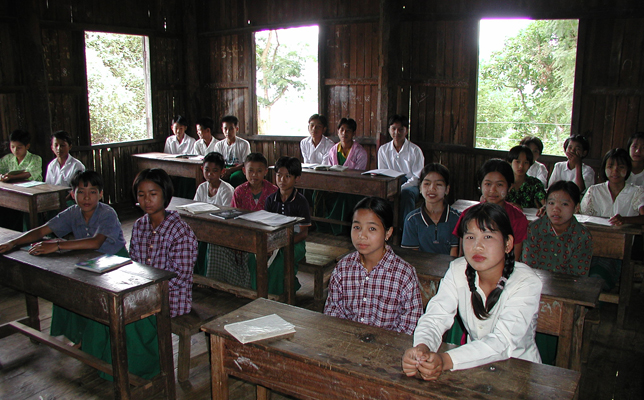
Children studying at the school which was constructed by the support of Saetanar (photo credit Saetanar)
Our lantern project does not end with simply giving products. The 100 Thousand Solar Lanterns Project gives lanterns with the sincere hope that they will prove useful in solving social challenges in areas without electricity. For that reason, we are careful when selecting our recipients. During the year after the donations have been made, we ask recipients to submit reports of how the solar lanterns are being used. In promoting this project, we take it upon ourselves to ensure that the solar lanterns are playing a true part in improving people's lives in areas with no or only limited electricity.
We are confident that Saetanar will put the solar lanterns to good use because they are an organization that respects the local people's independence and promotes initiatives that further build this independence.
From Myanmar, we traveled to Cambodia in early December and donated solar lanterns to nine organizations. One was the United Nations Educational, Scientific and Cultural Organization (UNESCO.) The donation to UNESCO was based on our strategic partnership agreement and presented in a ceremony at a hotel in Siem Reap on December 3. We also visited offices of the remaining eight organizations to present a letter of donation.
On December 2, we visited the Joint Support Team for Angkor Preservation and Community Development (JST) and the Kamonohashi Project in their offices in Siem Reap. Both organizations were recipients of the previous donation of solar lanterns in March 2012.
After our visit to JST, we visited Bayon Junior High School, built by JST, and watched as the children immersed themselves in their studies. The solar lanterns will be used in education-related activities at the school.
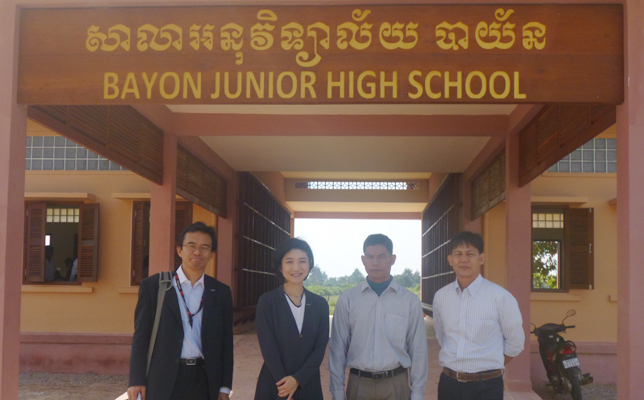
The school principal (second from right) guided us through Bayon Junior High School.
With the Kamonohashi Project, we presented a letter of donation at the Community Factory which I had visited on my previous trip. Here, the employees use the lanterns while sewing, but they have also come up with the unique idea of lending the solar lanterns as an incentive to employees with a high attendance rate to the lunch-time literacy classes. We are sure that the recently-donated solar lanterns will also be used effectively and creatively.
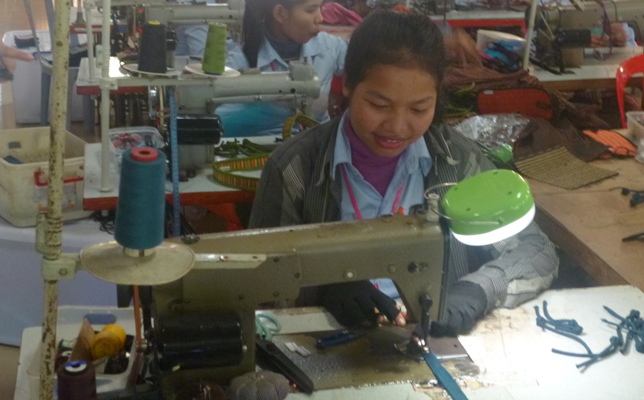
We asked an employee to try out the new solar lantern while she sewed on a machine. The lantern provided enough light to see what she was doing.
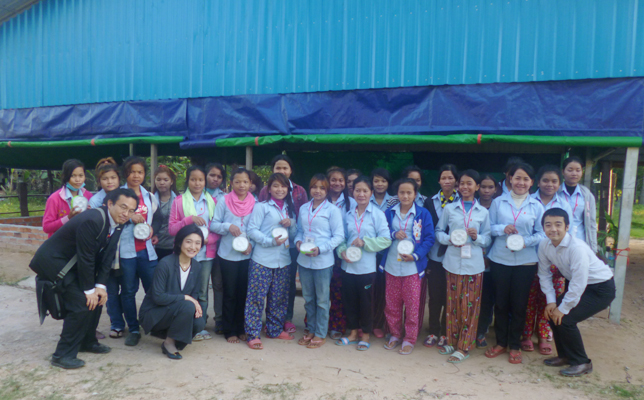
Group shot with the employees of the second workshop's satellite factory. Solar lanterns will be used here as well.
On December 4, we traveled to Phnom Penh to visit six organizations. Four of them received solar lanterns from our company in 2012, so this was their second time--Association of School Aid in Cambodia (ASAC), Caring for Young Khmer (CYR/CYK), International Federation of Red Cross and Red Crescent Societies (IFRC) Cambodia Office, and Services for the Health in Asian & African Regions (SHARE).

Donation to ASAC (left) and CYR/CYK (right)

Donation to IFRC (left) and SHARE (right)
Cambodia Education Assistance Fund (CEAF) and Life With Dignity (LWD) were first-time recipients. CEAF operates a junior high school named Cambodia-Japan Friendship Middle and High School in Prey Veng Province and is dedicated to providing education for children who will contribute to society in the future. The solar lanterns will be used for education at this middle school.
Meanwhile, LWD will be using the solar lanterns in their initiatives to raise awareness of health and hygiene and providing support and education to families in extreme poverty.
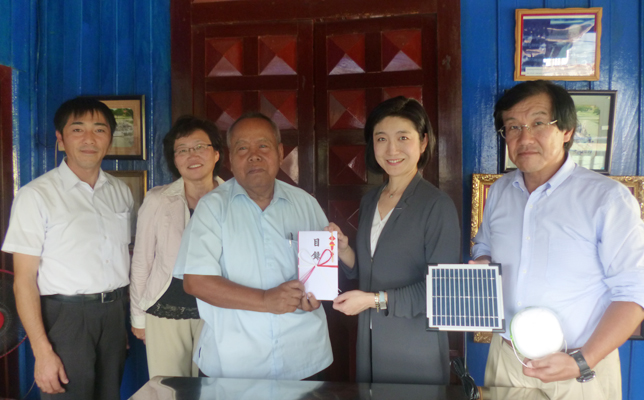
CEAF representative Mr. Kong Vorn (center) was once a refugee in Japan. The letter of donation was presented by Michiko Ogawa, Panasonic's CSR & Citizenship Group General Manager (second from right.)
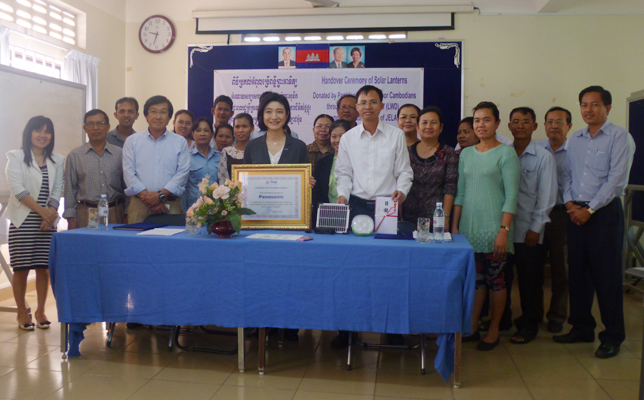
LWD organized a presentation ceremony and gave us a touching thank you letter.
After the presentation, CYR/CYK, which was active in providing education to children and supporting women's self-reliance, gave us a tour. When we arrived at the Weaving Training Center in Takeo Province, the heart of their women's empowerment activities, we were delighted to see that the previously-donated solar lanterns were still in use.
The Weaving Training Center teaches women traditional weaving techniques for their economic independence. Every year, ten women live at the center to attain expert weaving skills in one year. Women who complete the training can receive a weaving machine and further support by being able to sell their work to CYR/CYK.
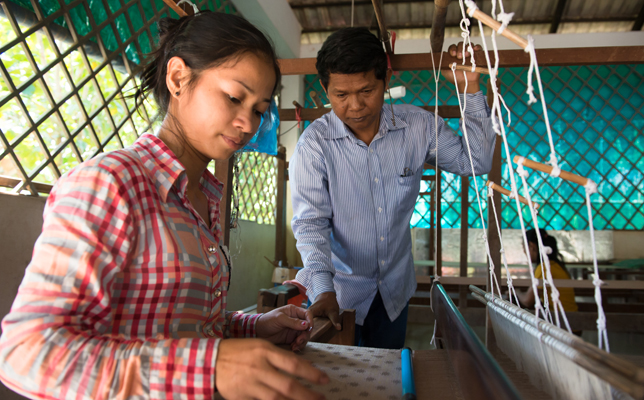
In addition to teaching the techniques, CYR/CYK also provides a system which brings income to women through the woven goods.
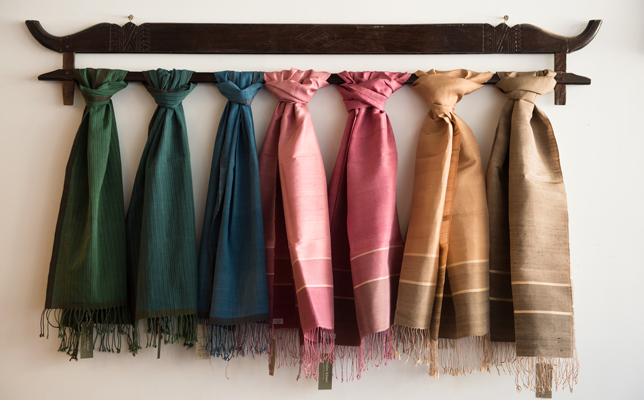
Colorful scarves woven at the Weaving Training Center.
I especially remember how the women at the center worked late into the night, not wanting to waste a minute of their precious time and learning as much as they could. The center has fluorescent lights but this is not enough for work in the evening. That is where the solar lantern comes in handy. Best of all, the new models can be hung on a wall, a feature which everybody loved.
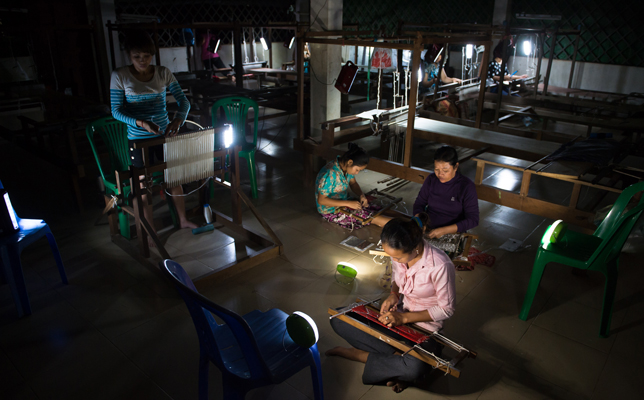
Women work silently into the night with their solar lanterns propped up against or hung from a wall.
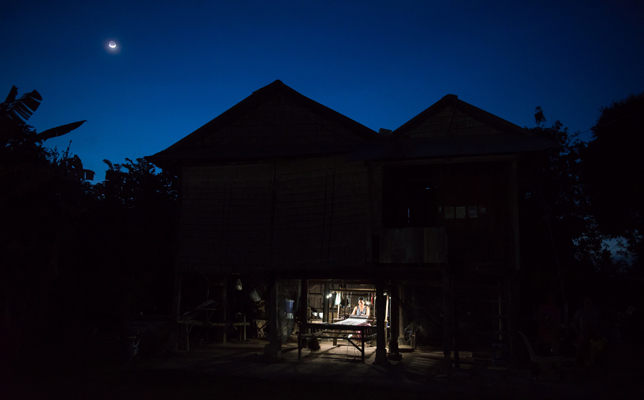
A woman working in her home. The first floor of the stilted house is her work space.
In recent years, both Myanmar and Cambodia have been achieving steady economic growth, but there are still many areas where people live without electricity. Additionally, rural areas have electricity along the main roads, but even just a few steps away from the road, home might have no electrical access, or families may be too poor to afford it. In Myanmar, where electricity is generated mostly by hydropower, electrical blackouts occur frequently during the dry season.
Myanmar and Cambodia are on the path of development, but many people are still left behind. That is why we want to deliver our solar lanterns to the people who need them most. To do so, we do our best to follow local information and actively support organizations that are doing their best to solve social challenges. We remain committed to continue with our solar lantern project and monitor how they are used, with great hope that they will light up the lives of the local people.